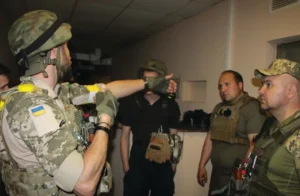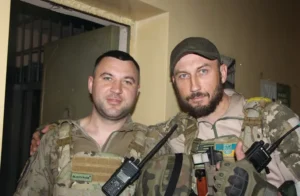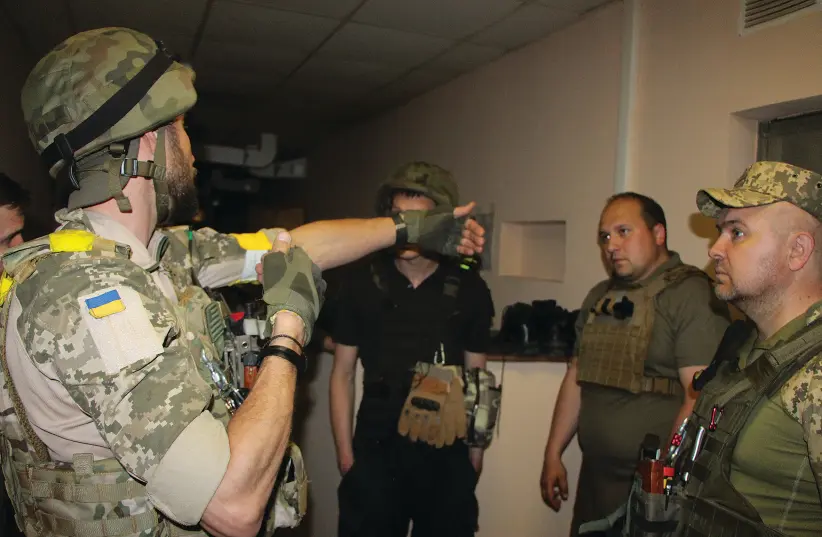BEHIND THE LINES: The preservation of its sovereignty will depend on its own ability to hold out, and the willingness of the West to retain focus, and to provide weapons systems.

“After 2014 I saw what was going on here, what Russia was doing, but it didn’t seem so abnormal. But what’s happening now is completely different. It’s not army against army. Terrible things are happening here. So it became necessary to help.”
Lev, 42, a Russian-born Israeli volunteer with the Ukrainian army, takes a sip of his orange juice and continues. “People I knew who came back from Bucha, from Gostomel, had aged years in weeks because of the things they had seen. They didn’t know where the cruelty came from. The Russians don’t care. They are doing things that are forbidden according to all the laws of war.”
“People I knew who came back from Bucha, from Gostomel, had aged years in weeks because of the things they had seen. They didn’t know where the cruelty came from. The Russians don’t care. They are doing things that are forbidden according to all the laws of war.”
Lev
We are sitting in a café close to Kyiv’s Independence Square. I am on the way to the Donbas. Lev is on leave from his unit, which is stationed in the Kharkiv area.
Kyiv has reacquired an atmosphere of near normality. It’s very different from when I was last here, in the first days of the war, in early March. Then, the streets were deserted. Uniformed men and machine-gun posts. The main railway stations were crowded with thousands of residents of the city and people fleeing from the east, all seeking to board the evacuation trains for the Polish border.
And now? A pleasant early summer scene. Couples and families in the restaurants and cafés. Cars on the road. The railway station restored to its former easy routine. There are still air raid sirens every few hours, but people pay them little heed. It has been a while since Kyiv took a direct hit.

There is still a curfew, from 11 every evening. The war has not disappeared. But its central point is now hundreds of kilometers to the east. And the human desire for normalcy is very great. A close simulation of it has therefore returned to the Ukrainian capital, even as the war in the east rages on, and nothing is resolved.
So I sit and listen as Lev, one of a reported 200 Israeli volunteers with the Ukrainians, tells me his story. Aliyah from St. Petersburg in 1996, living in Tiberias and then Bat Yam, service as a fighter in the Border Police during the Second Intifada, then some time working in the Prisons Service, in the Ayalon Prison. An IT job that took him to Kyiv, and a decision to stay. And then February 24, the Russian invasion, and his decision to join up with the defending Ukrainian forces. A month’s training (“minimal stuff, really basic. We were helping them with it, to be honest”). And then deployment to the Kharkov front, facing daily bombardments from Russian artillery.
The Israelis are spread out through the volunteer units, he tells me. There are five or six others in his platoon. The volunteer units in the army are themselves fully integrated into the Ukrainian forces, with a platoon of volunteers attached to a company of the regular army.
And what of the war itself? Where is it headed?
“At the beginning, someone gave the Russians false information. And they thought they’d come in and be greeted with flowers. That didn’t happen. So they ran away from Kyiv….
“What’s happening now is complicated. In Kherson, Mariupol and elsewhere they’re digging a trench system, close to the civilian population. They [the Russians] don’t let people leave, and they’re keeping the civilian population as hostages.”
I will hear various iterations of this picture throughout my time in Ukraine. Yes, the achievements around Kyiv in March and April are a reason for pride, especially when the world seemed to have written the Ukrainians off, seeing their position as hopeless. But now, a long and bloody grind has begun. Russia currently controls 20% of the territory of Ukraine – up from the 7% that it held before the commencement of the current war in February of this year. And slowly, they are moving forward in the Donbas region.
Moscow has abandoned the attempt at mobile warfare with which it began its assault. Now, the artillery is the main force. Up and down the line, but with greatest intensity in the Donbas area, the Ukrainians face daily bombardments. The firing is indiscriminate, the intention presumably to render life impossible and cause civilians to flee.
According to Ukrainian President Volodymyr Zelensky, 60-100 Ukrainian soldiers are being killed every day. One source told me of an infantry platoon in Severodonetsk that suffered 40% casualties in one day of fighting – three dead, six wounded from an original force of 24 fighters. This is a rate of attrition that will be difficult to sustain.
THE WAR makes itself apparent gradually, as you head eastward from Kyiv. More and more military traffic on the road, tanks and artillery pieces on transporters, infantry units in their armored vehicles shifting position.
As one enters the Donbas, the full extent of what is taking place becomes apparent. In towns such as Kramatorsk, Slovyansk and Bakhmut, the destruction wrought by the Russian artillery is visible everywhere. Buildings have been reduced to rubble by the artillery fire. Most of the residents have left. Those who remain are the ones too poor to leave, or with responsibilities to look after aged or infirm relatives who aren’t able to make the move.
“There is a lot of shelling at night, so a lot of stress. All day and all night,” Lubov, a retired warehouse worker in Bakhmut, tells us.
“There’s no work now, and we receive no help from the state. And I tell them, if we receive no help, don’t bother defending us. Because you’re not defending us. Look at this beautiful city, clean, with flowers, and one bomb can destroy it all.” She casts her hand around expansively, and then turns to face us, pausing for a moment as though expecting an explanation. Staring at us with the clear, piercing blue eyes that every second person here seems to have.
“I’m 64 years old, and I only want peace,” she concludes. “I don’t support any side, not the Russians, and not the Ukrainian army, but just to live in peace.”
Lubov asks where we are from, and she nods sagely when I tell her I have come from Israel. “Some of my son’s friends have roots in Israel, and they received help. They care about their people, it seems. Free studies, and so on. And we here – well, as I described.”
We received similar testimonies from a number of civilians that we spoke to. One cannot draw firm conclusions from a random selection of passersby, of course. But it is worth remembering that the Donbas is very far from being a hotbed of Ukrainian nationalist sentiment. It is Russian-speaking. It was one of the centers of Soviet industry. And it was the home ground of the deposed president Viktor Yanukovich. All those who were in Kyiv during the Maidan protests in 2013-14 vividly remember the Donbas coalminers bused in by Yanukovich’s government, to provide unauthorized extra muscle for the security forces.
Given this background, it is perhaps hardly surprising that enthusiastic support for Zelensky’s government seemed thin on the ground. It is also pertinent to note that those with greater faith in the government in Kyiv are more likely to be numbered among the people fleeing westward to seek its protection. Among those who have stayed, meanwhile, there is certainly a percentage, impossible to exactly quantify, who wait for the arrival of Putin’s armies with anticipation rather than dread.
A Ukrainian officer who I interviewed at a position east of Bakhmut, indeed, laconically noted that he and his men suspected that there were those among the remaining civilian population that were reporting directly to the Russian forces, providing details of the Ukrainian army’s deployments.
As we pushed further east, the civilian cars gradually disappeared. To get to Lysychansk, which faces the inferno of Severodonetsk across the river, you must pass through a system of deserted dirt tracks, leading through agricultural land. The sudden appearance before us of a Ukrainian military helicopter, flying at just above tree level, heading toward Severodonetsk, told us that we had arrived to the front line.
The Russians control most of Severodonetsk now. The remaining Ukrainian defenders are gathered in the Azot chemical plant, close to the Siverskyi Donets River. Lysychansk, on higher ground on the other bank, is consequently the recipient of the close attention of the Russian artillery war. The tide of the crawling, grinding style of war that the Russians have adopted in eastern Ukraine currently reaches this nondescript Donbas town.
The shelling is near constant. Sometimes distant, sometimes nearer. The few civilians who have remained are living in conditions primitive in the extreme. For over a month, there has been no running water, no electricity, no gas supply. Deliveries of bread arrive twice a week, one of the civilians tells us.
Even the collection of the bodies of those killed in the shelling is erratic. They have started temporary burials in the rough ground close by the buildings. A man called Andrei Babenko, killed by the shelling on May 22, is buried there. There is an open plot next to his grave, waiting for the next victim of the shelling.
The soldiers at the first-line positions have the surreal humor that is common to front lines everywhere, the product of lack of sleep and constant closeness to death.
“Mossad!” one of them calls out, on hearing that I am from Israel, and then, seeing my doubtful look, “Yasam!” (the Israel Police Special Patrol Unit) as a kind of compromise.
THE PROSPECTS facing Lysychansk are grim. Control of these towns is the key to Russian conquest of Luhansk province, which forms the northern part of the Donbas. Once they fall, if they fall, Kramatorsk, Slovyansk and the others are likely to follow. Russia will then be set to roll down the remainder of the Donbas. At this point, the Russians may pause and perhaps even offer negotiations. There is little doubt, however, that any arrangement would offer only a temporary respite. Putin’s goal is the destruction of independent Ukraine as a viable state.
For this reason, the Ukrainian resistance in Severodonetsk and Lysychansk is fierce and ongoing.
The soldiers I spoke to there echoed Lev in Kyiv regarding the road ahead. In the basement of the Lysychansk police station, as shells flew overhead, they told us that they were there to buy time, to slow the grinding advance of the Russians as much as possible before the heavy weaponry they hope to receive from the West starts to arrive and be integrated into their army. The M777 howitzers and the HIMARS artillery system are the systems on which they place hope. Their intention is to first seek to match the Russian artillery, and later to turn the Russians back from their latest conquests.
In the meantime, which probably means for the next few months, the daily attrition is likely to continue, the soldiers snatching what rest they can in their brief moments of leave in curiously peaceful Kyiv and further west, and the civilians preserving as much as possible of the lives they had before February 24.
Ukraine, at present, is neither lost nor saved, its fate not yet sealed. The preservation of its sovereignty will depend on its own ability to hold out, and the willingness of the West to retain focus, and to provide weapons systems.
As Lev, the volunteer from the Border Police and Bat Yam via St. Petersburg put it to me in Kyiv, “I believe we’ll get them out of here in the end, but it won’t happen quickly – and it’s going to take a high cost in human lives.”•

